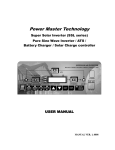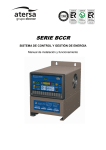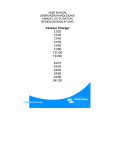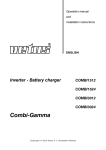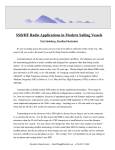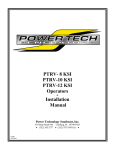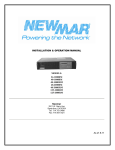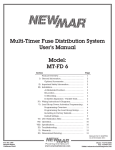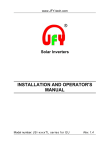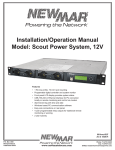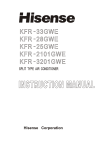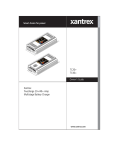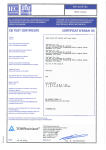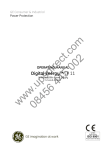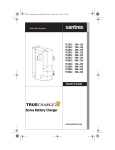Download 12-1850IC IP Inverter/Charger
Transcript
PURE SINE WAVE INVERTER / ATS / BATTERY CHARGER Models: 12-1850IC IP, 12-3550IC IP, 24-3550IC IP, 24-3550IC IPF TECHNICAL MANUAL M-Inverter IP As of April 09 CONTENTS Introduction ……………………………………………………………………………………..IV Specification ............................................................................................................................ Dimension ............................................................................................................................... Ⅵ Ⅷ Chapter 1 Installation ........................................................................................................... 1-1 1.1 Box Contents .................................................................................................. 1-1 1.2 Location .......................................................................................................... 1-1 1.3 Requirements ................................................................................................. 1-1 1.4 Connection of Battery Cables ........................................................................ 1-1 1.5 Connection of AC Cabling ............................................................................. 1-1 1.6 Optional Connections..................................................................................... 1-3 1.7 Grounding ...................................................................................................... 1-3 1.8 Remote Control Panel (RCP-3) ..................................................................... 1-3 Chapter 2 Control Modes ..................................................................................................... 2-1 2.1 Four Control Modes Application .................................................................. 2-1 Auto 1: AC Power as Priority Support ......................................................... 2-1 Auto 2: AC Generator Support with Dynamic Power Shifting ........................................... 2-4 Inverter Only Mode ....................................................................................... 2-6 Charger Only Mode ....................................................................................... 2-8 Chapter 3 Wiring .................................................................................................................. 3-1 3.1 Front Panel Display ....................................................................................... 3-1 3.2 Panel Connection ........................................................................................... 3-4 3.3 Battery Connection ........................................................................................ 3-5 Capter 4 User Constants ....................................................................................................... 4-1 4.1 Structure of User Constants .......................................................................... 4-2 4.2 Operation Flow .............................................................................................. 4-6 II Chapter 5 Constants List ...................................................................................................... 5-1 U Group: Monitor................................................................................................ 5-1 A Group: Initialize ............................................................................................... 5-2 B Group: General ................................................................................................ 5-2 C Group: Inverter................................................................................................ 5-3 D Group: Charger ............................................................................................... 5-3 E Group: Aux-Relay ............................................................................................ 5-3 O Group: Operator .............................................................................................. 5-8 Chapter 6 Programming Constants ..................................................................................... 6-1 A Group: Initialize ............................................................................................... 6-1 B Group: General ................................................................................................ 6-3 C Group: Inverter................................................................................................ 6-8 D Group: Charger ..............................................................................................6-10 E Group: Aux-Relay ...........................................................................................6-13 O Group: Operator.............................................................................................6-19 U Group: Monitor...............................................................................................6-21 Chapter 7 Trouble Shooting Table ....................................................................................... 7-1 Factory Contact Info……………………………………………………………….7-4 III Introduction General Multi-functional Feature The “Intelligence Plus” is a powerful true sine wave inverter, a sophisticated battery charger that features adaptive charge technology and a high-speed AC Auto Transfer Switch (ATS) in a single compact enclosure. Besides these primary functions, however, the Intelligence Plus has several advanced features that provide a range of new applications as outlined below: Uninterrupted AC Power In the event of a grid failure, or shore or generator power being disconnected, the inverter within the Intelligence Plus is automatically activated and takes over supply to the connected loads. This happens so fast (less than 10 milliseconds) that computers and other electronic equipment will continue to operate without disruption. Power Control-Dealing with limited generator or shore side power The “Intelligence Plus” is a very powerful battery charger. It will therefore draw a lot of current from the generator or shore side power. A maximum generator or shore current can be set (B2-05). The “Intelligence Plus” will then take account of other AC loads and use whatever is extra for charging thus preventing the generator or shore supply from overload. Power Assist-Boosting the capacity of shore or generator power This feature takes the principle of Power Control to a farther dimension allowing the “Intelligence Plus” to supplement the capacity of the alternative source. Where peak power is so often required only for a limited period; it is possible to reduce the size of generator needed or conversely enable more to be achieved from typically limited shore connection. When the load reduces, the spare power is used to recharge the battery. Battery Charger 4-stage charge characteristic: Bulk-Absorption-Float-Equalize The “Intelligence Plus” features a microprocessor controlled battery management system that can be preset to suit different types of batteries. Preventing damage due to excessive gassing: The Battery Safe Mode If, in order to quickly charge a battery, a high charge current in combination with a high absorption voltage has been chosen. The “Intelligence Plus” will prevent damage due to excessive gassing by automatically limiting the rate of voltage increase once the gassing voltage has been reached. Less maintenance and aging when the battery is not in use: The Equalize Mode The equalize mode kicks in whenever the battery has not been subjected to discharge during IV 24 hours. In the equalize mode, float voltage is reduced to 2.2V/cell (13.2V for 12V battery) to minimize gassing and corrosion of the positive plate. One a week, the voltage is raised back to absorption level to “equalize” the battery. This feature prevents stratification of the electrolyte and sulphation, a major cause of early battery failure. 2 outputs to charge 2 battery banks The “Intelligence Plus” features 2 outputs, of which 1 can carry the full output current. The second output, limited to approximately 4A and with a slightly lower output voltage, is intended to top up a starter battery. To increase battery life: Temperature Compensation Every “Intelligence Plus” can come with an optional battery temperature sensor (BTS-3) when connected, charge voltage will automatically decrease with increasing battery temperature. This feature is especially recommended for sealed batteries and/or when important fluctuation of battery temperature is expected. Battery Voltage Sense In order to compensate for voltage loss due to cable resistance, the “Intelligence Plus” is provided with a voltage sense facility so that the battery always receives the correct charge voltage. Product Registration Newmar warrants that this Inverter-Charger be free from defects in material and workmanship for two years from date of purchase. If you wish to register our product with us and provide comments or questions, please log onto www.newmarpower.com/product_registration.html or for immediate response to your questions or comments, please call tech service at 1-800-241-3897 or E-mail: [email protected]. V Specification 12 Volt System MODEL 12-1850 ICIP 12-3550 ICIP 24 Volt System 24-3550 ICIP GENERAL Ventilation Temperature – Operation – Storage Forced cooling Forced cooling -20 -20 ℃~ +70℃ -25℃~ +80℃ ℃~ +70℃ -25℃~ +80℃ Protection a. Output short circuit Yes Yes b. Over load Yes Yes c. Battery voltage too high Yes Yes d. Battery voltage too low Yes Yes e. DC voltage ripple too high Yes Yes (105℃) (70℃) (50℃) (105℃) (70℃) (50℃) 0~95% (non condensing) 0~95% (non condensing) Power control Function Yes Yes Power assist Function Yes Yes Uninterrupted AC power (less than 10 msec) (less than 10 msec) Adaptive 4-stage charge Yes Yes Two output to charge 2 battery banks Yes Yes Auxiliary Relay X3 X3 Battery voltage sensor Yes Yes Battery Temperature sensor (BTS-3) Yes Yes Remote control port Yes Yes f. Temperature Sensor Transformer Electronic & Powerstage BTS-3 Humidity INVERTER Input Voltage Range (VDC) 9.5 -16V / 19-32V Output Voltage (VAC) 185~240 VAC / 90~120 VAC Output Frequency 50Hz /60Hz ± 0.1% Output Waveform Pure sinewave < 5% Output Voltage THD Yes Power Factor (All Loads) No linger load, crest factor 3: 1 VI Output Wattage (Models) 1500 W 3000 W Continuous 1500 W 3000 W 30 Minutes 1800 W 3500 W 5 Minutes 2000 W 4000 W 5 Seconds 3000 W 6000 W 3000W 6000W 82/84/85 84/86/89 12W 18W Maximum Power (W) Maximum Efficiency (%) Zero-load Power (W) CHARGER Input Voltage Range (VAC) 200~250 VAC / 100~125 VAC Input Frequency 45-55Hz /55-65 Hz Power Factor 1 Charge Characteristic 4-stage / Bulk-Absorption-Float-Equalize < 1.25 V Maximum DC Voltage Ripple (Vrms) Charge Current House Battery (A) 70A/40A 140A/70A Charge Current Starter Battery (A) 4A Absorption Voltage Default (VDC) 14.2V / 28.4V Float voltage Default (VDC) 13.4V / 26.8V Output Charge Voltage (min ~ max) 8V~16V / 11V~32V Battery Temperature sensor BTS-3 AC INPUT SWITCH AC IN Terminal Circuit Breaker 30A (110V) /15A (220V) 60A (110V) /30A (220V) Switch-over Time a. inverter to AC input 0 msec. b. AC input to inverter 0 msec. Detection Time AC Input Fault 4 ~10 msec. Trip Level AC Input to Inverter 90 VAC / 180 VAC Trip Level Inverter to AC Input 94 VAC / 187 VAC Min.~ Max. Frequency Range 45-55 Hz / 55-65 Hz MECHANICAL Cabinet / Protecting Class Dimension (HXWXD) Aluminum / IP20 12 x 12 x 14.4 inches 12 x 17.1 x 14.4 inches 66 lbs 77 lbs Weight (lbs) VII Dimension for Intelligence Plus 1850W 12/24 Unit: Inches VIII Dimension for Intelligence Plus 3550W Series 12 VDC Unit: Inches IX Dimension for Intelligence Plus 3550W Series 24 VDC Units = Inches X Chapter 1: Installation 1-1 This product should be installed by a qualified electrician. 1) IMPORTANT SAFETY CAUTIONS AND WARNINGS CAUTION: Inverters produce hazardous voltages. To avoid risk of harm or fire, the unit must be properly installed. There are no user-serviceable parts inside. Do not remove the inverter housing. CAUTION: The inverter should not be mounted in a location that may be exposed to rain or spray. CAUTION: The inverter should not be installed in zero-clearance enclosure. CAUTION: Damage to the inverter will occur if correct polarity is not observed when installing the DC input cables. CAUTION: Damage to the inverter will occur if an external AC source is applied to the inverter’s AC output. CAUTION: The inverter contains a circuit breaker and capacitor that may produce a spark. Do not mount in a confined battery or gas compartment. CAUTION: Working in the vicinity of lead-acid batteries is dangerous. Batteries generate explosive gasses during operation. There is a risk of acid exposure. There is also a risk of high current discharge from shorting the battery that can cause fire and explosion. CAUTION: UL and ABCY specify that the DC input shall be fused no further than 18” from the battery. This is the responsibility of the installer. CAUTION: Be sure both the inverter and, if used, the external AC input circuit breaker or fuse are turned “OFF” during installation. WARNING: The inverter/charger is not ignition protected, so it must not be located in an area where ignition protected equipment is required. EXTERNAL CONNECTIONS TO THE INVERTER/CHARGER SHALL COMPLY WITH UL RECOMMENDATIONS AND/OR UNITED STATES COAST GUARD ELECTRICAL REGULATIONS (33CFR183, SUB-PART I) THE INSTALLATION AND PROTECTION OF VESSEL WIRING ASSOCIATED WITH INVERTER/CHARGERS SHALL COMPLY WITH ABYC STANDARDS, E-11 AC & DC 1-2 ELECTRICAL SYSTEMS ON BOATS AND A-31 BATTERY CHARGING DEVICES AND INVERTERS. 1.1 Box Contents Intelligence Plus Inverter-Charger USER MANUAL Bag Containing connection items, ie: Four (4) terminals and casing One (1) Black & One (1) Red Input Cover Four (4) screws with washer attached BTS-3 Temp Sensor Two (2) mounting brackets Six (6) flat Phillips head screws 1.2 Location The product must be installed in a dry and well-ventilated area, as close as possible to batteries. There should be a clear space of at least 8 inches around the appliance for cooling. Excessively high ambient temperature will result in the following Reduced service life Reduced charge current Reduced peak capacity or shutdown of the inverter Never position the appliance directly above the batteries. Intelligence Plus is suitable for wall mounting. The back and the bottom of the enclosure has holes for wall mounting purposes. For horizontal mounting, attach the two mounting brackets provided to the bottom of the Intelligence Plus with the six flat Phillips head screws. The bottom of the mounting brackets has holes for horizontal mounting. The interior of the product must remain accessible after installation. Ensure the AC and DC input cables are fitted with fuses and circuit breakers. Try and keep the distance between the product and battery to a minimum in order to minimize cable voltage losses. For safety purpose, this product should be installed in a heat-resistant environment if it is used with equipment where a substantial amount of power is to be converted. You should prevent the presence of e.g. chemicals, synthetic components, curtains or textiles, etc. in the immediate vicinity. 1.3 Requirements Philips screwdriver for removing the lower-front panel and connecting AC loads. 2 battery cables (maximum length 20 feet) Including battery terminals and cable ends. Insulated socket wrench or nut driver (13 mm) for securing the DC terminal nuts. Three-wire cable for AC cabling. 1-3 Mounting screws or bolts 1.4 Connection of Battery Cables In order to fully utilize the full capacity of the product, batteries with sufficient capacity and battery cables with sufficient cross section should be used, please see table: Wire Size Chart Model Length of Wire from Charger to Batteries (in feet) 10' 15' 20' Over 20' Minimum Wire Gauge (AWG) 12-1850IC IP 12-3550IC IP 24-3550IC IP #1/0 #2/0 #1/0 #1/0 #4/0 #2/0 #2/0 #4/0 #2/0 Not recommended Not recommended Not recommended *Meets minimum requirements of ABYC 10% voltage drop table for inverter maximum input current, 3% voltage drop table for charger maximum output, and allowable amperage for 105⁰ C rated insulation conductors <50 VDC inside engine space. Consult ABYC E-11 for lower temperature rated insulated conductors. CAUTION: Ensure that leads are properly fused at the battery. (Refer to ABYC recommendations regarding fuse type and location.) Refer to the chart following chart for proper battery fuse value for each model: DC Fuse Chart Model Fuse Value 12-1850IC IP 12-3550IC IP 250 Amp 500 Amp 24-3550IC IP 250 Amp Procedure: Proceed as follows to connect the battery cables: Use an insulated socket wrench or nut driver in order to avoid shorting the battery. Avoid shorting the battery cables: Undo the four screws at the lower-front panel of the enclosure and remove the panel. Connect the battery cable: the + (red) on the right and the – (black) on the left. Please see page 3-4 and 3-5. Don’t reverse the (+) and (-) of the battery. This may cause internal damage. Tighten the connections after positioning the fastening items supplied with product. Secure the nuts tightly in order to reduce the contact resistance as much as possible. 1-4 1.5 Connection of AC Cabling The enclosure must be grounded for safety purpose. An earth screw has been fitted at the bottom side of the enclosure. The terminal block can be found at lower-front panel of the enclosure: The shore or mains (AC IN) cable must be connected to AC IN terminals. This wire should be at least 10 AWG for 30 amp service and 6 AWG for 50 amp service Procedure: Proceed as follows to connect the AC cables. The AC output cable can be connected directly to terminal block containing the word “AC OUT”. The terminal points are indicated clearly. From left to right: “G” (earth), “N” (neutral), and “L” (Line). The AC input cable can be connected to the terminal block containing the word “AC IN”, the terminal points are indicated clearly from left to right “L” (Line), “N” (neutral), and “G” (earth). The current which is switched through to the output (AC OUT) is not fused. External fuses or current limiters have to be installed. 1.6 Optional Connections A number of operational connections are possible: 1.6.1 Second Battery The “Intelligence Plus” has a connection for trickle charging (up to 4 amps) a starter battery. For connection, see page 3-4 and 3-5. 1.6.2 Voltage Sense Two sense wires may be connected to compensate possible battery cable losses during charging. Use wires of at least 16 gauge. For connection, see page 3-4 and 3-5. 1.6.3 Battery Temperature Sensor (BTS-3) The battery temperature sensor supplied with the product may be used for temperature compensated charging, see page 3-4 and 3-5. The sensor is insulated and must be mounted on the batteries minus post. 1.6.4 3 Sets of Auxiliary Relay (RY1, RY2, RY3) Output The “Intelligence Plus” provides 3 sets of Auxiliary Relays for users to connect to other appliances or to output the alarm signals. 3 sets of relays can be programmed for respective function (E Group Constants) and can be practically applied which is one of the greatest features. 1.7 Grounding When the input voltage of the Intelligence Plus is not switched through, the neutral of “AC OUT” is automatically connected to ground by means of a relay. There is a DC case ground connection going out the lower front of the wiring compartment, see 3-4 and 3-5. 1.8 Remote Panel: P/N 430-4000-0 1-5 The product can be operated remotely from the remote jack with the aid of a remote control panel. For connection of a remote control panel, see page 3-1. Note: The display panel and operation flow of the remote control panel is exactly the same as the upper-front display panel. For panel dimensions, dimensional drawing found on next page. Dimensions for Intelligence Plus Remote Control Panel Units = mm Panel Installation Cut-out Dimensions: 209mm(W) X 94mm(H) 1-6 Chapter 2 Control Modes 2.1 Four Control Modes Applications (examples shown is 230 VAC/12 VDC model) AUTO 1: AC Power as Priority Support When Intelligence Plus enters to AUTO 1, B2-09 (AC IN DynaCur Limit)=0 (Disable) and the value of B2-18 (AUTO 1: ACINCurrent Lmt) will be loaded to B2-05. 1. INVERTER Mode: When AC IN=0 A, AC OUT load is completely supplied by INVERTER. It goes to the inverter mode. Grid,Shore,Generator Power 0A AC IN 5A ATS OFF 5A 75A Battery 2-1 AC OUT Load 2. Power Control Mode (a) In this example: All AC loads are off, with the “Intelligence Plus” constant B2-05=5A (AC IN Current Limit), the AC CHARGER will not take more than 5A with limits to battery charge current to 75A. Shore Power Max 5A 5A AC IN ATS ON 5A 0A AC OUT Load B2-05=5A 5A 75A Battery 3. Power Control Mode (b) Now some small loads are switched on and load increase to 3A. Only 5-3=2A is left to charge the batteries and charge current is reduced to about 30A. ※ Note: Shore current is automatically limited to 5A and the AC input circuit breaker will not trip! Shore Power Max 5A 3A 5A AC IN ATS ON 2A B2-05=5A 5A 30A Battery 2-2 AC OUT Load 4. Power Control Mode (c) The load is switched on and current consumption increase to 5A. Nothing is left to charge the battery. The charge current is automatically reduced to 0A, and the AC input circuit breaker does not trip! Shore Power Max 5A 5A AC IN 5A ATS ON 0A Load AC OUT B2-05=5A 5A Battery 5. Power Assist Mode And now the other load adds and switches on and the current increases to 11A. This is where Power Assist is needed. The bidirectional converter starts operating as inverter to add 6A to the 5A that is available from the shore-side: Total 6+5=11A, and no overload on the AC supply. As soon as the load reduces to less than 5A, any current that is left over will be used to recharge the battery. Shore Power Max 5A 11A 5A AC IN ATS ON 6A B2-05=5A 5A 90A Battery 2-3 AC OUT Load AUTO 2: AC Generator Support with Dynamic Power Shifting When Intelligence Plus enters to AUTO 2, B2-09(AC IN DynaCur Limit)=1 (Enable) and the value of B2-19 (AUTO 2: ACINCurrent Lmt) will be loaded to B2-05. 1. INVERTER Mode: When AC IN=0 A, AC OUT load is completely supplied by INVERTER. It goes to the inverter mode. Grid,Shore,Generator Power 0A AC IN ATS OFF 5A 5A AC OUT Load 75A Battery 2. Power Control Mode (a) In this example: All AC loads are off, with the “Intelligence Plus” constant B2-05=5A (AC IN Current Limit), the AC CHARGER will not take more than 5A with limits to battery charge current to 75A. Shore Power Max 5A 5A AC IN ATS ON 5A B2-05=5A 5A 75A Battery 2-4 0A AC OUT Load 3. Power Control Mode (b) Now some small loads are switched on and load increase to 3A. Only 5-3=2A is left to charge the batteries and charge current is reduced to about 30A. ※ Note: Shore current is automatically limited to 5A and the AC input circuit breaker will not trip! Shore Power Max 5A 3A 5A AC IN ATS ON 2A Load AC OUT B2-05=5A 5A 30A Battery 4. Power Control Mode (c) The load is switched on and current consumption increase to 5A. Nothing is left to charge the battery. The charge current is automatically reduced to 0A, and the AC input circuit breaker does not trip! Shore Power Max 5A 5A AC IN 5A ATS ON 0A B2-05=5A 5A Battery 2-5 AC OUT Load INVERTER ONLY When Intelligence Plus enters to INVERTER ONLY, B2-09(AC IN DynaCur Limit)=0 (Disable) and the value of B2-20 (INV M: ACINCurrent Lmt) will be loaded to B2-05. 1. INVERTER Mode: When the battery voltage is not lower than (B2-14) voltage value, inverter mode takes priority to supply voltage to AC OUT for load consumption. (INVERTER ON+ ATS OFF + AC CHARGER OFF) Shore Power Ready 3A AC IN ATS OFF 3A Load AC OUT B2-05=5A 5A 45A Battery 2. Power Control Mode When AC IN power is ready, INVERTER is active and battery voltage is lower than B2-14 voltage value and longer than the second time set in B2-15, ATS will be switched on to ensure AC OUT to continuously supply the load. At the moment, AC OUT will be supplied by AC IN power. When AC IN power is ready, it is only used to supply to the load, not to charge the battery. (INVERTER OFF+ ATS ON + AC CHARGER OFF) 2-6 Shore Power 3A AC IN 3A ATS ON AC Charger OFF Load AC OUT B2-05=5A 5A Battery 3. Power Assist Mode And now the other load adds and the current increases to 11A. This is where Power Assist function is needed! (ATS ON + AC CHARGER OFF + INVERTER ON + Power Assist Mode ON) As soon as the load reduces to less than 5A, power assist function stops. Shore Power 11A 5A AC IN ATS ON 6A B2-05=5A 5A 90A Battery 2-7 AC OUT Load CHARGER ONLY When Intelligence Plus enters to CHARGER ONLY, B2-09 (AC IN DynaCur Limit)=0 (Disable) and the value of B2-21 (CHG M: ACINCurrent Lmt) will be loaded to B2-05. 1. NO AC IN Power: When AC IN=0 A, AC OUT load is not supplied and the AC Charger is not working. Grid,Shore,Generator Power 0A AC IN 0A ATS OFF Load AC OUT 0A Battery 2. Power Control Mode (a) In this example: All AC loads are off, with the “Intelligence Plus” constant B2-05=5A (AC IN Current Limit), the AC CHARGER will not take more than 5A with limits to battery charge current to 75A. Shore Power Max 5A 5A AC IN ATS ON 5A B2-05=5A 5A 75A Battery 2-8 0A AC OUT Load 3. Power Control Mode (b) Now some small loads are switched on and load increase to 3A. Only 5-3=2A is left to charge the batteries and charge current is reduced to about 30A. ※ Note: Shore current is automatically limited to 5A and the AC input circuit breaker will not trip! Shore Power Max 5A 3A 5A AC IN ATS ON 2A Load AC OUT B2-05=5A 5A 30A Battery 4. Power Control Mode (c) The load is switched on and current consumption increase to 5A. Nothing is left to charge the battery. The charge current is automatically reduced to 0A, and the AC input circuit breaker does not trip! Shore Power Max 5A 5A AC IN 5A ATS ON 0A B2-05=5A 5A Battery 2-9 AC OUT Load Chapter 3 Wiring 3.1 Front Panel Display 2 1 5 PB9 PB8 7 4 PB7 PB6 PB5 PB4 PB3 PB2 3 9 8 6 PB 1 Push Buttons Push buttons PB1 Name RUN/STOP Intelligence Plus RUN/STOP key PB2 DSPL PB3 ENTER PB4 DOWN PB5 UP PB6 PB7 PB8 PB9 Description Multi-display select key Data write-in key () () Decrement key Increment key AC Input power to charge the battery. Function Key to move Cursor to the right digit at Parameter Edit. Before changing DC power from battery to supply to AC loads. from one Function Key to move Cursor to the left digit at mode to Parameter Edit. another, it AC Generator Support with Dynamic Power Shifting. has to stop Function Key to return to Main Menu “Programming” running and be in STOP mode. AC Power as Priority Support. Function Key to return to Main Menu “Operation”. 3-1 Note: 1. When pressing RUN/STOP key, the holding time to remain on the key has to be at least 2 seconds (initial setting) to activate the RUN or STOP function in order to avoid any accidental pressing on the RUN/STOP key. The second time can be adjusted in RUN/STOP KeyHoldTime (O2-07). 2. When changing any of four modes to another mode, Intelligence Plus has to STOP and then press the desired mode key. When pressing AUTO 1 key or AUTO 2 key or INV only key or CHG only key, the holding time remaining on the key has to be at least 5 seconds (initial setting) to activate the mode change in order to avoid any accidental pressing on the mode keys. The second time can be adjusted in MODE Key Hold Time (O2-06). 3. The beep sound of key pressing can be selected to be enabled or disabled in Key Pressed Beep Sel (O2-01) 4. When all the keys are not pressed at all for a certain time (O1-02), it goes to idle mode. Once any key is pressed, the display will return to the LCD monitor selection value set in constant O1-01. 5. When all the keys are not pressed at all for a certain time (O2-09), all the LCD Display and LED Indicators are not active but RUN/STOP indicator remains active. The display idle function can save the display power. 6. When users are programming under any level of Groups or Function or Parameters or Parameters Edit, press key for 1 second to return to Main Menu “Operation” immediately. 7. When users are programming under any level of Groups or Function or Parameters or Parameters Edit, press key for 1 second to return to Main Menu “Programming” immediately. 8. When adjusting the parameters values, press key to key to enable cursor to move left for one digit and press key to enable cursor to move right for one digit. Model No. Display Software 12-1850IC IP IP-1850-121 12-3500IC IP IP-3550-121 24-3550IC IP IP-3550-241 24-3550IC IPF IP-3550-242 3-2 LED Indicators LED Name L ED ON LED OFF 1. Input voltage normal, and position 1 AC IN > ”transfer Voltage Level” (150VAC~240VAC) No input power 2. Input voltage frequency range in between(45~65Hz) 2 AC CHARGER Green : Battery charger is working. 3 AC OUT There is voltage at the “AC OUT” terminal. 4 INVERTER Green : Inverter is working. 5 BATTERY FLOAT or ABSOR. Or BULK charge state of battery. ATS Green : ATS switch is active AC IN voltage is being sent directly to AC OUT terminal 6 7 RUN/STOP Green : Intelligence Plus turn on. Red : Intelligence Plus turn off. NOTE: Green Blink : Auto-Restart is in use 8 COM./ERR. Remote control port in communication/in error 9 REMOTE Remote Control Panel Jack 3-3 3.2 Panel Connection 3.2.1 Lower-Front Panel Connection for Intelligence Plus C B A D E F N M L Ref. Letter A B C D E F G H I J K L M N K J I H G Connections / Lower Front Description CHARGE +/BTS +/Vsens +/- Terminals for starting battery of 4A Terminals for battery temperature sensor Terminals for Remote Battery Voltage Sensing RY1 contacts RY2 contacts RY3 contacts AC OUT L AC OUT N AC OUT G AC IN G AC IN N AC IN L Battery POS+/ NEGDC Case Ground Terminals for auxiliary relay contact 1 Terminals for auxiliary relay contact 2 Terminals for auxiliary relay contact 3 Terminals for AC output: Line Terminals for AC output: Neutral Terminals for AC output: Ground Terminals for AC input: Ground Terminals for AC input: Neutral Terminals for AC input: Line Terminals for battery cables Terminals for DC Case Ground 3-4 3.3 Battery & AC Connections 3.3.1 Connection Schematic 3-5 Chapter 5 Constants List Factory Menu Group Function Constant LCD Display Range Unit Remark Page Setting Operation U Monitor U1 U2 U3 Monitor U1-01 AC IN Voltage U1-02 AC IN Current U1-03 AC OUT Voltage U1-04 AC OUT Current U1-05 Battery Voltage U1-06 Battery Ripple Volt U1-07 Battery Current U1-08 Control Mode U1-09 Operation Status U1-10 Aux-Relay Status U1-11 Elapsed Time U1-12 Bat.Temp.Sensor U1-13 CPU ID 1 U1-14 CPU ID 2 Fault U2-01 Current Fault Trace U2-02 Last Fault U2-03 AC IN Voltage U2-04 AC IN Current U2-05 AC OUT Voltage U2-06 AC OUT Current U2-07 Battery Voltage U2-08 Battery Ripple Volt U2-09 Battery Current U2-10 Control Mode U2-11 Operation Status U2-12 Aux-Relay Status U2-13 Elapsed Time U2-26 Bat.Temp. Sensor Fault U3-01 Last Fault History U3-02 Fault Message 2 U3-03 Fault Message 3 U3-04 Fault Message 4 U3-05 Elapsed Time 1 - - - - - - - - - - - - - - - - - - - - - - - - - - - - - - - - - 0.1V 0.1A 0.1V 0.1A 0.1V 0.1V 0.1A - - - 1hour 1°C - - - - 0.1V 0.1A 0.1V 0.1A 0.1V 0.1V 0.1A - - - 1hour 1°C - - - - 1hour - - - - - - - - - - - - - - - - - - - - - - - - - - - - - - - - - 6-21 6-21 6-21 6-21 6-21 6-21 6-21 6-21 NOTE 1 6-22 NOTE 2 6-22 6-22 6-22 6-22 6-22 6-23 6-23 6-23 6-23 6-23 6-23 6-23 6-23 6-24 6-24 NOTE 1 6-24 NOTE 2 6-24 6-24 6-24 6-25 6-25 6-25 6-25 6-25 Factory Menu Group Function Constant LCD Display Range Unit Remark Setting 5-1 Page Operation Initialize U A Monitor Initialize U3 A1 Fault U3-06 Elapsed Time 2 History U3-07 Elapsed Time 3 U3-08 Elapsed Time 4 A1-01 Access Level - - - 1hour 1hour 1hour - - - Initialize 6-25 6-25 6-25 0: Operation Only 0~1 1 1 6-1 1: Constant Set A1-02 Select Language - - 0 A1-03 Init Parameters 0~1 1 0 0:English 6-1 0: No Initialize 6-1 1:Default Setting Programm- B General B1 ing A1-04 Password 1 B1-01 Output Frequency 0~999 1 0 0~1 1 0 Output 0: 50 Hz Frequency B2 6-2 6-3 1:60 Hz Auto B2-01 AC IN Low Disconnect NOTE 3 1V NOTE 3 6-3 Transfer B2-02 AC IN Low Connect NOTE 3 1V NOTE 3 6-3 Switch B2-03 AC IN High Connect NOTE 3 1V NOTE 3 6-4 B2-04 AC IN High Disconnect NOTE 3 1V NOTE 3 6-4 B2-05 AC IN Current Limit NOTE 3 0.1A NOTE 3 6-4 0~1 1 1 AC IN Waveform 0: Ignore B2-06 Check 6-4 1: Active 0: Disconnect B2-07 Ground Relay 0~1 1 1 6-5 1: Connect 0:50/60Hz+-5Hz B2-08 ACIN Frequency Range 0~1 1 1 6-5 1:45Hz~65Hz 0: Normal B2-09 AC IN DynaCur Limit 0~1 1 0 6-5 1:Dynamic INV M: BatLo?V ATS 0~32.0 B2-14 23.5V 0.01V ON 0~16.0 INV M: BatLo?S 6-6 11.75V ATS B2-15 0~255 1 sec 10 sec 6-6 ON INV M: BatHi?V 0~32.0 B2-16 28.8V 0.01V ATSOFF 0~16.0 6-6 14.4V INV M: BatHi?S B2-17 0~255 1 sec 60 sec 6-6 NOTE 3 0.1A NOTE 3 6-7 NOTE 3 0.1A NOTE 3 6-7 ATSOFF AUTO1:ACINCurrent B2-18 Lmt AUTO2:ACINCurrent B2-19 Lmt 5-2 Factory Menu Group Function Constant LCD Display Range Unit Remark Page Setting Programm- B General B2 Auto INV M:ACINCurrent B2-20 ing Transfer NOTE 3 0.1A NOTE 3 6-7 NOTE 3 0.1A NOTE 3 6-7 Lmt Switch CHG M:ACINCurrent B2-21 Lmt C Inverter C1 Inverter C1-01 Inverter Out Voltage NOTE 3 1V NOTE 3 6-8 C1-02 Bat Low ? V Shut-down NOTE 3 0.01V NOTE 3 6-8 C1-03 Bat Low ? V Restart NOTE 3 0.01V NOTE 3 6-8 C1-04 Auto Power Saving 0~1 1 1 0: Disable 6-8 1: Enable 0: Disable C1-05 Power Assist Select 0~1 1 1 6-8 1: Enable C1-06 D Charger D1 Power Assist Level 1.0~3.5 0.1 2.0 Charger 6-9 1: Fixed D1-02 Charge Curve 1~3 1 3 2: Adaptive 6-10 3: Adaptive+safe D1-03 Absorption Voltage D1-04 Rep-Absorption Time NOTE 3 0.01V NOTE 3 0.25 1~72 6-11 4x0.25=1 hour 4 6-11 hour 0.25 D1-05 Rep-Abs Interval 1~180 28x0.25=7day 28 6-11 day D1-06 Max. Absorption Time 1~8 1hour 4hour 6-11 D1-07 Float Voltage NOTE 3 0.01V NOTE 3 6-11 D1-08 Charge Current NOTE 3 1A NOTE 3 6-11 D1-09 Stop After 10Hr Bulk 0~1 1 1 0:Disable 6-11 1:Enable 0:Disable D1-10 Equalize Mode Select 0~1 1 1 6-12 1:Enable 1:Flooded/AGM1 2:AGM 2 D1-11 Battery Type Select 0-3 1 1 6-12 3:Gel 4:User E Aux-Relay E1 Set Aux- E1-01 LOAD Higher than ? A NOTE 3 0.01A NOTE 3 6-13 Relay 1 E1-02 LOAD Higher for ? sec 0~255 1sec 0sec 6-13 ON E1-03 Udc Lower than ? V NOTE 3 0.01V NOTE 3 6-13 E1-04 Udc Lower for ? sec 0~255 1sec 0sec 6-13 E1-05 Udc Higher than ? V NOTE 3 0.01V NOTE 3 6-13 E1-06 Udc Higher for ? sec 0~255 1sec 0sec 6-13 5-3 E1-07 Not Charge for ? sec 0~255 1sec 0sec 6-13 E1-08 Fan On for ? sec 0~255 1sec 0sec 6-13 Range Unit Factory Menu Group Function Constant LCD Display Remark Page Setting Programm- E Aux-Relay E1 Set Aux- 0:Disable E1-09 ing When bulk Protection 0~1 1 0 Relay 1 6-14 1:Enable ON 0:Disable E1-10 System Fault Occurs 0~1 1 0 6-14 1:Enable 0:Alarm E1-11 Temp. Alarm Sel 0~1 1 0 6-14 1:Pre-alarm E1-12 Temp. Alarm for ?sec 0~255 1sec 0sec E1-13 Low Batt. Alarm Sel 0~1 1 0 6-14 0:Alarm 6-14 1:Pre-alarm E1-14 Low Batt. for ? sec 0~255 1sec 0sec E1-15 Overload Alarm Sel 0~1 1 0 6-14 0:Alarm 6-14 1:Pre-alarm E1-16 OL Alarm for ? sec E1-17 Udc Ripple Alarm Sel 0~255 1sec 0sec 0~1 1 0 6-14 0:Alarm 6-14 1:Pre-alarm E2 E1-18 UdcRipAlarm for ? sec 0~255 1sec 0sec 6-14 Set Aux- E2-01 Load Lower than ? A NOTE 3 0.01A NOTE 3 6-15 Relay 1 E2-02 Load Lower for ? sec 0~255 1sec 0sec 6-15 OFF E2-03 Udc Lower than ? V NOTE 3 0.01V NOTE 3 6-15 E2-04 Udc Lower for ? sec 0~255 1sec 0sec 6-15 E2-05 Udc Higher than ? V NOTE 3 0.01V NOTE 3 6-15 E2-06 Udc Higher for ? sec 0~255 1sec 0sec 6-15 E2-07 Charging for ? sec 0~255 1sec 0sec 6-15 E2-08 Fan Off for ? sec 0~255 1sec 0sec 6-16 E2-09 Charge Finished ? Min 0~1000 1min 0 6-16 E2-10 RY1 not ON for ? mins 0~1000 1min 0 6-16 E2-11 AC IN Loss for ? sec 0~255 1sec 0sec 6-16 E2-12 No Temp. Alarm Sel 0~1 1 0 0:Alarm 6-16 1:Pre-alarm E2-13 No Temp. Alarm ? sec 0~255 1sec 0sec E2-14 No Low Bat. Alarm Sel 0~1 1 0 6-16 0:Alarm 6-17 1:Pre-alarm E2-15 No Low Bat for ? sec 5-4 0~255 1sec 0sec 6-17 Factory Menu Group Function Constant LCD Display Range Unit Remark Page Setting Programm- E Aux-Relay E2 Set Aux- 0:Alarm E2-16 ing No OL Alarm Sel 0~1 1 0 Relay 1 OFF 6-17 1:Pre-alarm E2-17 No OL Alarm for ? sec 0~255 1sec 0sec 0~1 1 0 No UdcRipple Alarm E2-18 6-17 0:Alarm Sel 6-17 1:Pre-alarm No UdcRipple E2-19 0~255 1sec 0sec 6-17 Alarm ?sec E3 Set Aux- E3-01 Load Higher than ? A NOTE 3 0.01A NOTE 3 6-17 Relay 2 E3-02 Load Higher for ?sec 0~255 1sec 0sec 6-17 ON E3-03 Udc Lower than ? V NOTE 3 0.01V NOTE 3 6-17 E3-04 Udc Lower for ? sec 0~255 1sec 0sec 6-17 E3-05 Udc Higher than ? V NOTE 3 0.01V NOTE 3 6-17 E3-06 Udc Higher for ? sec 0~255 1sec 0sec 6-17 E3-07 Not Charge for ? sec 0~255 1sec 0sec 6-17 E3-08 Fan On for ? sec 0~255 1sec 0sec 6-17 E3-09 When bulk Protection 0~1 1 0 0:Disable 6-17 1:Enable 0:Disable E3-10 System Fault Occurs 0~1 1 0 6-17 1:Enable 0:Alarm E3-11 Temp. Alarm Sel 0~1 1 0 6-17 1:Pre-alarm E3-12 Temp. Alarm for ?sec 0~255 1sec 0sec E3-13 Low Batt. Alarm Sel 0~1 1 0 6-17 0:Alarm 6-17 1:Pre-alarm E3-14 Low Batt. for ? sec 0~255 1sec 0sec E3-15 Overload Alarm Sel 0~1 1 0 6-17 0:Alarm 6-17 1:Pre-alarm E3-16 OL Alarm for ? sec E3-17 Udc Ripple Alarm Sel 0~255 1sec 0sec 0~1 1 0 6-17 0:Alarm 6-17 1:Pre-alarm E4 E3-18 UdcRipAlarm for ?sec 0~255 1sec 0sec 6-17 Set Aux- E4-01 Load Lower than ? A NOTE 3 0.01A NOTE 3 6-17 Relay 2 E4-02 Load Lower for ? sec 0~255 1sec 0sec 6-17 OFF E4-03 Udc Lower than ? V NOTE 3 0.01V NOTE 3 6-17 5-5 Factory Menu Group Function Constant LCD Display Range Unit Remark Page Setting Programm- E Aux-Relay E4 ing Set Aux- E4-04 Udc Lower for ? sec 0~255 1sec 0sec 6-17 Relay 2 E4-05 Udc Higher than ? V NOTE 3 0.01V NOTE 3 6-17 OFF E4-06 Udc Higher for ? sec 0~255 1sec 0sec 6-17 E4-07 Charging for ? sec 0~255 1sec 0sec 6-17 E4-08 Fan OFF for ? sec 0~255 1sec 0sec 6-17 E4-09 Charge Finished ?Min 0~1000 1min 0 6-17 E4-10 RY2 not ON for ?mins 0~1000 1min 0 6-17 E4-11 AC IN Loss for ?sec 0~255 1sec 0sec 6-17 E4-12 No Temp. Alarm Sel 0~1 1 0 0:Alarm 6-17 1:Pre-alarm E4-13 No Temp. Alarm ? sec 0~255 1sec 0sec E4-14 No Low Bat. Alarm Sel 0~1 1 0 6-17 0:Alarm 6-17 1:Pre-alarm E4-15 No Low Bat for ? sec E4-16 No OL Alarm Sel 0~255 1sec 0sec 0~1 1 0 6-17 0:Alarm 6-17 1:Pre-alarm E4-17 No OL Alarm for ? sec 0~255 1sec 0sec 0~1 1 0 No UdcRipple Alarm E4-18 6-17 0:Alarm Sel 6-17 1:Pre-alarm No UdcRipple E4-19 0~255 1sec 0sec 6-17 Alarm ?sec E5 Set Aux- E5-01 Load Higher than ? A NOTE 3 0.01A NOTE 3 6-17 Relay 3 E5-02 Load Higher for ?sec 0~255 1sec 0sec 6-17 ON E5-03 Udc Lower than ? V NOTE 3 0.01V NOTE 3 6-17 E5-04 Udc Lower for 0~255 1sec 0sec 6-17 E5-05 Udc Higher than ? V NOTE 3 0.01V NOTE 3 6-17 E5-06 Udc Higher for ? sec 0~255 1sec 0sec 6-17 E5-07 Not Charge for ? sec 0~255 1sec 0sec 6-17 E5-08 Fan ON for ? sec 0~255 1sec 0sec 6-17 E5-09 When bulk Protection 0~1 1 0 ? sec 0:Disable 6-17 1:Enable 0:Disable E5-10 System Fault Occurs 0~1 1 0 6-17 1:Enable 5-6 Factory Menu Group Function Constant LCD Display Range Unit Remark Page Setting Programm- E Aux-Relay E5 Set Aux- 0:Alarm E5-11 ing Temp. Alarm Sel 0~1 1 0 Relay 3 ON 6-17 1:Pre-alarm E5-12 Temp. Alarm for ?sec 0~255 1sec 0sec E5-13 Low Batt. Alarm Sel 0~1 1 0 6-17 0:Alarm 6-17 1:Pre-alarm E5-14 Low Batt. for ? sec 0~255 1sec 0sec E5-15 Overload Alarm Sel 0~1 1 0 6-17 0:Alarm 6-17 1:Pre-alarm E5-16 OL Alarm for ? sec E5-17 Udc Ripple Alarm Sel 0~255 1sec 0sec 0~1 1 0 6-17 0:Alarm 6-17 1:Pre-alarm E6 E5-18 UdcRipAlarm for ?sec 0~255 1sec 0sec 6-17 Set Aux- E6-01 Load Lower than ? A NOTE 3 0.01A NOTE 3 6-17 Relay 3 E6-02 Load Lower for ? sec 0~255 1sec 0sec 6-17 OFF E6-03 Udc Lower than ? V NOTE 3 0.01V NOTE 3 6-17 E6-04 Udc Lower for ? sec 0~255 1sec 0sec 6-17 E6-05 Udc Higher than ? V NOTE 3 0.01V NOTE 3 6-17 E6-06 Udc Higher for ? sec 0~255 1sec 0sec 6-17 E6-07 Charging for ? sec 0~255 1sec 0sec 6-17 E6-08 Fan OFF for ? sec 0~255 1sec 0sec 6-17 E6-09 Charge Finished ?Min 0~1000 1min 0 6-17 E6-10 RY3 not ON for ?mins 0~1000 1min 0 6-17 E6-11 AC IN Loss for ?sec 0~255 1sec 0sec 6-17 0:Alarm E6-12 No Temp. Alarm Sel 0~1 1 0 E6-13 No Temp. Alarm ? sec 0~255 1sec 0sec E6-14 No Low Bat. Alarm Sel 0~1 1 0 1:Pre-alarm 6-17 6-17 0:Alarm 6-17 1:Pre-alarm E6-15 No Low Bat for ? sec E6-16 No OL Alarm Sel 0~255 1sec 0sec 0~1 1 0 6-17 0:Alarm 6-17 1:Pre-alarm E6-17 No OL Alarm for ? sec 5-7 0~255 1sec 0sec 6-17 Factory Menu Group Function Constant LCD Display Range Unit Remark Page Setting Programm- E Aux-Relay E6 Set Aux- No UdcRipple Alarm E6-18 ing Relay 3 0:Alarm 0~1 1 0 Sel OFF 6-17 1:Pre-alarm No UdcRipple E6-19 0~255 1sec 0sec 0~1 1 0 6-17 Alarm ?sec E7 Aux- 0:Do not use Aux E7-01 Aux1 Usage Select Relay 1 6-18 1: Use Aux Option 0: Normal E7-02 Aux1 Invert Select 0~1 1 0 6-18 1: Invert switch E8 E7-03 Aux1 notSwitchOff T E8-01 Aux2 Usage Select 0~1000 1 min 0 0~1 1 0 Aux- 6-18 0:Do not use Aux Relay 2 6-18 1: Use Aux Option 0: Normal E8-02 Aux2 Invert Select 0~1 1 0 6-18 1: Invert switch E9 E8-03 Aux2 notSwitchOff T E9-01 Aux3 Usage Select 0~1000 1 min 0 0~1 1 0 Aux- 6-18 0:Do not use Aux Relay 3 6-18 1: Use Aux Option 0: Normal E9-02 Aux3 Invert Select 0~1 1 0 6-18 1: Invert switch O Operator O1 O2 E9-03 Aux3 notSwitchOff T 0~1000 1 min 0 Monitor O1-01 Power-ON Monitor Sel 0~13 1 4 Select O1-02 Key Idle Detect Time 10~600 1sec 180 sec O2-01 Key Pressed Beep Sel 0~1 1 1 Key 6-18 NOTE 4 6-19 6-19 0:Disable Selections 6-19 1:Enable O2-02 Elapsed Time Reset 0~60000 1hour 0 O2-03 Elapsed Time Select 0~1 1 0 6-19 0:Power ON 6-19 1: Run Time O2-04 Intelligence Plus Model - - - 6-19 O2-06 MODE Key Hold Time 2~10 1sec 5 sec 6-20 2~10 1sec 2 sec 6-20 0~1 1 1 RUN/STOP O2-07 KeyHoldTime 0: Manual O2-08 Auto Run Select 6-20 1: Auto O2-09 Display IdleTime Set 5-8 0~60 1min 10 min 6-20 NOTE 1: Operation Status U1-09 = X X X X X X X X X X X X Fault: RUN/STOP: 0=OK Udc ripple: 1=Fault 0=OK 0=STOP Inverter: 1=RUN 1=Udc-ripple 0=OFF Pre-alarm 1=ON AC CHARGER: 0=OFF ATS: 1=ON 0=OFF 1=ON AC IN: 0=AC IN disconnect 1=AC IN connect AC OUT: 0=No output 1=output Remoter: 0=Remoter disconnect 1=Remoter connect OH: 0=OK 1=OH Pre-alarm Battery Low: 0=OK 1=Battery low pre-alarm OL: 0=OK 1=Over load pre-alarm 5-9 NOTE 2: U1-10 = X X X Aux-Relay1: 0=OFF 1=ON Aux-Relay2: 0=OFF 1=ON Aux-Relay3: 0=OFF 1=ON NOTE 3: Constants B2-01 B2-02 Factory Range B2-04 Factory Unit Model B2-03 Range Unit Setting Factory Range Factory Unit Range Setting Unit Setting Setting 24-3550 IC IPF 180~230 1V 180V 181~260 1V 187V 240~269 1V 265V 230~270 1V 270V 12-1850 IC IP 94~120 1V 94V 95~135 1V 101V 128~142 1V 138V 120~143 1V 143V 12-3550 IC IP 94~120 1V 94V 95~135 1V 101V 128~142 1V 138V 120~143 1V 143V 24-1850 IC IP 94~120 1V 94V 95~135 1V 101V 128~142 1V 138V 120~143 1V 143V 24-3550 IC IP 94~120 1V 94V 95~135 1V 101V 128~142 1V 138V 120~143 1V 143V Constant B2-05 C1-01 Factory Range Un Unit Model C1-02 Factory Range it Setting Factory Factory Range Setting C1-03 Unit Range Unit Setting Setting 24-3550 IC IPF 1.0~16.0 0.1A 16.0A 210~245 1V 230V 18.6~23.0 0.01V 18.6V 21.8~34.0 0.01V 21.8V 12-1850 IC IP 2.0~30.0 0.1A 30.0A 94~128 1V 120V 9.3~13.0 0.01V 9.3V 10.9~17.0 0.01V 10.9V 12-3550 IC IP 2.0~30.0 0.1A 30.0A 94~128 1V 120V 9.3~13.0 0.01V 9.3V 10.9~17.0 0.01V 10.9V 24-1850 IC IP 2.0~30.0 0.1A 30.0A 94~128 1V 120V 18.6~26.0 0.01V 18.6V 21.8~34.0 0.01V 21.8V 24-3550 IC IP 2.0~30.0 0.1A 30.0A 94~128 1V 120V 18.6~23.0 0.01V 18.6V 21.8~34.0 0.01V 21.8V Constant D1-03 D1-07 Factory Range Unit Model D1-08 Factory Range Unit Setting E1-01,E3-01,E5-01 Factory Range Unit Setting Factory Range Unit Setting Setting 24-3550 IC IPF 24.0~32.0 0.01V 28.4V 24.0~32.0 0.01V 26.8 0~70 1A 70A 0~42.6 0.01A 13.30A 12-1850 IC IP 12.0~16.0 0.01V 14.2V 12.0~16.0 0.01V 13.4V 0~70 1A 70A 0~44.7 0.01A 12.75A 12-3550 IC IP 12.0~16.0 0.01V 14.2V 12.0~16.0 0.01V 13.4V 0~140 1A 140A 0~83.0 0.01A 25.5A 24-1850 IC IP 24.0~32.0 0.01V 28.4V 24.0~32.0 0.01V 26.8V 0~35 1A 35A 0~44.7 0.01A 12.75A 5-10 24.0~32.0 24-3550 IC IP Constant 0.01V 28.80V E1-03,E3-03,E5-03 24.0~32.0 E1-05,E3-05,E5-05 Factory Range 27.60V 0~70 Range Unit Setting 1A 35A E2-01,E4-01,E6-01 Factory Unit Model 0.01V 0~83.0 0.01A E2-03,E4-03,E6-03 Factory Range Unit Setting 25.5A Factory Range Unit Setting Setting 24-3550 ICIP 0~35.0 0.01V 23.5V 0~35.0 0.01V 32.0V 0~42.6 0.01A 3.32A 0~35.0 0.01V 23.5V 12-1850 ICIP 0~17.5 0.01V 11.75V 0~17.5 0.01V 16.0V 0~44.75 0.01A 3.18A 0~17.5 0.01V 11.75V 12-3550 ICIP 0~17.5 0.01V 11.75V 0~17.5 0.01V 16.0V 0~83.0 0.01A 6.37A 0~17.5 0.01V 11.75V 24-1850 ICIP 0~35.0 0.01V 23.5V 0~35.0 0.01V 32.0V 0~44.75 0.01A 3.18A 0~35.0 0.01V 23.5V 24-3550 ICIP 0~35.0 0.01V 23.5V 0~35.0 0.01V 32.0V 0~83.0 0.01A 6.37A 0~35.0 0.01V 23.5V Constant E2-05,E4-05,E6-05 Factory Range Unit Model Setting 24-3550 IC IPF 0~35.0 0.01V 32.0V 12-1850 IC IP 0~17.5 0.01V 16.0V 12-3550 IC IP 0~17.5 0.01V 16.0V 24-1850 IC IP 0~35.0 0.01V 32.0V 24-3550 IC IP 0~35.0 0.01V 32.0V NOTE 4: Parameter Setting LCD Display O1-01= 0 AC IN Voltage 1 AC IN Current 2 AC OUT Voltage 3 AC OUT Current 4 Battery Voltage 5 Battery Ripple Volt 6 Battery Current 7 Control Mode 8 Operation Status 9 Aux-Relay Status 10 Elapsed Time 11 Bat.Temp.Sensor 12 CPU ID 1 13 CPU ID 2 A1-04=Password 1 Lock the constants setting (A1-01=1) 1. Finish setting all the programmable parameters to desired values. 5-11 2. Change A1-01=0 (Operation only), factory setting is A1-01=1 (Constants set). 3. Go to A1-04 and press RUN/STOP key and UP key at the same time till A1-05 parameter occurs. 4. Enter the desired password (max. 4 digits) 5. Press UP key to leave A1-05 Above procedure completes locking the constants setting and no more programming selection would appear. A1-01 would only display 0 (Operation only) and would not display 1 (Constants set). Unlock the constants setting 1. Enter the password in A1-04 to be exactly the same as the one earlier set in A1-05 2. When the password in A1-04 matches the one earlier set in A1-05, the unlocking is completed. A1-01=1 (Constants set) would appear again for programming. 5-12 Chapter 6 Programming Constants A Group (Initialize): A1 Group (Initialize) A1-01: Access level Use constant A1-01 to select the user constant access level. This level determines which user constants can be changed and displayed. Setting Function This setting allows the “operation” and “initialize” to be A1-01=0 A1-01=1 (Initial setting) changed or displayed. Use this setting to prevent user constant settings from being changed. This setting allows all user constants to be changed or displayed. A1-02: Select Language Use constant A1-02 to select the language displayed by the Intelligence Plus. A value of 0 set English and values of others set other language. This user constant is not returned to factory setting when constants are initialized. It must be manually reset to factory setting. Setting A1-02=0 (Initial setting) Function English language A1-02=1 Reserved, under development A1-02=2 Reserved, under development A1-02=3 Reserved, under development A1-02=4 Reserved, under development A1-02=5 Reserved, under development A1-02=6 Reserved, under development A1-03: Init Parameters Use constant A1-03 to initialize the user constants. When initialized, the user constants will return to their factory preset values. You should normally record the setting of any constants that are changed from factory presets. 6-1 Setting A1-03=0 (Initial setting) A1-03=1 Function Returns to initialize Display without initializing any user constants. Initializes the user constants to factory settings. A1-04: Init Password 1 This constant is reserved for the factory to test and set the functions. Users are not allowed to set this constant. Lock the constants setting (A1-01=1) 1. Finish setting all the programmable parameters to desired values. 2. Change A1-01=0 (Operation only), factory setting is A1-01=1 (Constants set). 3. Go to A1-04 and press RUN/STOP key and UP key at the same time till A1-05 parameter occurs. 4. Enter the desired password (max. 4 digits) 5. Press UP key to leave A1-05 Above procedure completes locking the constants setting and no more programming selection would appear. A1-01 would only display 0 (Operation only) and would not display 1 (Constants set). Unlock the constants setting 1. Enter the password in A1-04 to be exactly the same as the one earlier set in A1-05 2. When the password in A1-04 matches the one earlier set in A1-05, the unlocking is completed. A1-01=1 (Constants set) would appear again for programming. 6-2 B Group (General): B1 Group (Output Frequency) B1-01: Output frequency B1-01 is used to set the output frequency at INVERTER AC output Setting Function B1-01=0 (Initial setting) 50Hz at INVERTER AC output B1-01=1 60Hz at INVERTER AC output B2-08: AC IN Frequency Range Setting Function When B1-01=0: Acceptable AC input frequency is 50Hz ±5Hz B2-08=0 (45~55Hz) When B1-01=1: Acceptable AC input frequency is 60Hz ±5Hz (55~65Hz) B2-08=1 (Initial setting) Accept wide AC input frequency range between 45~65Hz B2 Group (Auto Transfer Switch) B2-01: AC IN Low Disconnect Use constant B2-01 to determine the AC IN voltage below which level the ATS (Auto Transfer Switch) will switch off. This voltage level will always lie below the AC IN Low Connect (B2-02) level. In fact, changing this level will also change the AC IN Low Connect (B2-02) level. B2-02: AC IN Low Connect This setting forms a pair with AC IN Low Disconnect (B2-01). With this setting, one determines the AC IN low voltage at which level the ATS will switch on. This should lie above AC IN Low Disconnect (B2-01) level to prevent continuous switching off the ATS when the voltage is fluctuating around the level. In fact, the parameter which is changed is the difference between AC IN Low Disconnect (B2-01) and AC IN Low Connect (B2-02). The result of this is that when changing B2-01 level, this level (B2-02) also 6-3 changes. ※ Note: B2-02 can be ignored for a short time when AC IN Waveform Check (B2-06) is disabled (B2-06=0) When the AC IN voltage drops due to the increasing charge current, the AC CHARGER will take care that the voltage does not drop below this level. B2-02=B2-01+offset voltage For example: C3-1500-122, when B2-01=180V, B2-02=187V, offset voltage=7V (187-180), B2-02 will automatically go to 197V(190+7) after B2-01 is changed to 190V. B2-03: AC IN High Connect This setting forms a pair with AC IN High Disconnect (B2-04). With this setting, one determines the AC IN high voltage at which level the ATS will switch on. This should lie below the AC IN High Disconnect (B2-04) level to prevent continuous switching of the ATS when the voltage is fluctuating around that level. In fact, the parameter which is changed is the difference between AC IN High Disconnect (B2-04) and AC IN High Connect (B2-03). The result of this is that when changing B2-04 level, this level (B2-03) also changes. B2-03=B2-04–offset voltage For example: C3-1500-122, when B2-03=265V, B2-04=270V, offset voltage=5V (270-265), B2-03 will automatically go to 255V(260–5) after B2-04 is changed to 260V. B2-04: AC IN High Disconnect Use constant B2-04 to determine the AC IN voltage above which level the ATS will switch off. This voltage level will always lie above the AC IN High Connect (B2-03) level. In fact, changing this level will also change the AC IN High Connect (B2-03) level. B2-05: AC IN Current Limit Use constant B2-05 to set the set the specific maximum AC input current. This value is very important for both battery charger and inverter output power assist. 6-4 When using constant B2-05, the values determine the actual AC current limit. ※Note: With Power Support enabled, there is a minimum value for the AC input current limit. Please see the note at Power Support (page 6-9). B2-06: AC IN Waveform Check Use constant B2-06 to enable/disable the fast detection of input voltage wave shape. Setting Function By disabling AC IN waveform check, AC IN Low Disconnect (B2-01) is ignored. When the load current is higher 1.5 times than AC In Current Limit (B2-05), this is used to prevent unnecessary switching to INVERTER due B2-06=0 (Ignore) to voltage drop when a high load is connected. B2-06=1 (Initial setting) (Active) This detection checks the wave shape, if it is not sinusoidal within certain limits, the AC input voltage is rejected. However, certain generator or very weak mains supply have an ill shaped sinusoidal output especially when the load suddenly changes. The fast detection will detect a failure in such a case. This will result in a slightly longer transfer time. B2-07: Ground Relay Used to enable/disable the internal ground relay functionality. The ground relay is useful when an earth-leakage circuit-breaker is part of the installation. When ATS (Auto Transfer Switch) is open (INVERTER mode), the Neutral of the inverter is connected to “G” terminal. When ATS closes (AC IN is transferred to AC OUT), the Neutral is first disconnected from “G” terminal. Setting B2-07=0 B2-07=1 (Initial setting) Function The internal ground relay is open with “G” terminal. The internal ground relay is closed with “G” terminal. B2-08: AC IN Frequency Range Refer to page 6-3 (B1-01) 6-5 B2-09: AC IN Dynamic Current Limit This setting is an expansion of the AC IN Current Limit (B2-05) mechanism. Setting B2-09=0 (Initial setting) Function The AC current limit is specified by the AC IN Current Limit (B2-05) setting 6-6 The effective AC input current limit depends on the load history. When the load is lower than the AC IN Current Limit (B2-05), the effective AC input current limit is also lower but slightly above the load. B2-09=1 When the load increase, the effective current limit also increases with a delay. The thought behind this is that when a generator is running at a low load, it can’t switch to full load immediately and it needs some time to increase the power. ※ An example: We have a 2KVA generator. We adjust the AC IN Current Limit (B2-05) setting to 8A and we enable Power Assist (C1-05=1). We have no load connected and the batteries are fully charged. Therefore, no current from generator is drawn. At this moment, we connect a load of 7A to the Intelligence Plus with this setting (B2-09) disabled, the Intelligence Plus would not react because the load is below the AC IN Current Limit (B2-05) setting. The result is that the full load is connected to generator which will drop in voltage because it can’t deliver that current instantly which could result in switching to INVERTER. If however we had this setting (Dynamic Current Limit) enabled, the effective AC input current limit would be far lower than 8A because the load was zero. So connecting a load of 7A will result in Intelligence Plus starting to power assist and no voltage drop is being examined on the AC OUT. The generator starts to supply the load and the effective AC input current limit will increase to 8A slowly. At the moment, the Intelligence Plus will stop Power Assist and the full load is on the generator. This is powerful option in combination with Power Assist but even without Power Assist, it can prevent unnecessary switching to INVERTER because the charge current will reduce when AC input current becomes higher than the effective AC input current limit. B2-14: INV only: Bat Lo?V ATS ON B2-15: INV only: Bat Lo?S ATS ON B2-16: INV only: Bat Hi?V ATSOFF B2-17: INV only: Bat Lo?S ATSOFF B2-14~B2-17 are used to set the condition of ATS to be ON/OFF in INVERTER Only mode. When Intelligence Plus is in INVERTER Only mode, INVERTER mode takes 6-7 priority to supply voltage to AC OUT for load consumption. When AC IN power is ready, INVERTER is active and battery is about to be exhausted, ATS will be switched on to ensure AC OUT to continuously supply the load. At the moment, AC OUT will be supplied by AC IN power. B2-14 and B2-15 are used to set ATS to be “ON” to supply AC IN power to the AC OUT load when the battery voltage is lower than B2-14 voltage value and longer than the second time set in B2-15 in INVERTER Only mode. (ATS ON+INVERTER OFF+AC CHARGER OFF) B2-16 and B2-17 are used to set ATS to be “OFF” when the battery voltage is higher than B2-16 voltage value and longer than the second time set in B2-17 in INVERTER Only mode. (INVERTER ON+ATS OFF+ AC CHARGER OFF) B2-18: AUTO1: ACIN Current Lmt Use constant B2-18 to set the specific maximum AC input current in AUTO 1. This value is very important for both battery charger and inverter output power assist. When using constant B2-18, the values will be loaded to B2-05 to determine the actual AC current limit in Auto 1 mode. B2-19: AUTO2: ACIN Current Lmt Use constant B2-19 to set the specific maximum AC input current in AUTO 2. This value is very important for both battery charger and inverter output power assist. When using constant B2-19, the values will be loaded to B2-05 to determine the actual AC current limit in Auto 2 mode. B2-20: INV only: ACIN Current Lmt Use constant B2-20 to set the set the specific maximum AC input current in INVERTER ONLY. This value is very important for both battery charger and inverter output power assist. When using constant B2-20, the values will be loaded to B2-05 to determine the actual AC current limit in Inverter Only mode. B2-21: CHG only: ACIN Current Lmt Use constant B2-21 to set the set the specific maximum AC input current in CHARGER ONLY. This value is very important for both battery charger and 6-8 inverter output power assist. When using constant B2-21, the values will be loaded to B2-05 to determine the actual AC current limit in Charger Only mode. C Group (INVERTER): C1 Group (INVERTER) C1-01: INVERTER Output Voltage Use constant C1-01 to change the RMS output voltage of the INVERTER. C1-02: Bat Low ?V Shut-down With this setting, one can determine the battery voltage at which level the INVERTER will switch off. This can be useful to prevent drawing too much current from an exhausted battery. This voltage level will always lie below the Bat Low ? V Restart (C1-03) level. In fact, changing this level will also change the Bat Low ? V Restart (C1-03) level. C1-03=C1-02+offset voltage For example: C3-1500-122, when C1-02=9.3V, C1-03=10.9V, offset voltage=1.6V (10.9-9.3), C1-03 will automatically go to 11.6V(10.0+1.6) after C1-02 is changed to 10.0V. C1-03: Battery Low ? V Restart This setting forms a pair with Bat Low ? V Shut-down (C1-02). With this setting, one determines the battery voltage at which level the INVERTER will switch on. In fact, the parameter which is changed is the difference between Bat Low ? V Shut-down (C1-02) and Bat Low ? V Restart (C1-03). The result of this is that when changing the Bat Low ? V Shut-down (C1-02) level, this level also changes. C1-04: Auto Power Saving When there is no load connected, set C1-04=1 (Initial setting) to active the power saving function by reducing the output voltage to be 144V for 220V model and to be 72 for 110V model. Setting C1-04=0 can disable the auto power saving and the output voltage would be continuously supplied as the same default voltage even when there is no load connected. 6-9 C1-05: Power Assist Select Using this constant C1-05, the Power Assist feature can be enabled or disabled. Use Power Assist to prevent an external circuit breaker to trip when the load on the Intelligence Plus is too high. If the load exceeds the AC IN Current Limit (B2-05), the Intelligence Plus will start inverting and will provide the extra current needed. ※ Note: When Power Assist is enabled. C1-05=1 (Initial setting), there is a minimum AC input current limit of approximate 2-3 Amps. Setting a lower limit (B2-05) than this minimum value will result in the minimum limit. Setting Function C1-05=0 Power Assist Function is disabled. C1-05=1 (Initial setting) Power Assist Function is enabled. C1-06: Power Assist Level This setting is a special setting for power assist mode when the Intelligence Plus is charging and due to a sudden load, the AC IN current exceeds the AC IN Current Limit (B2-05), the Intelligence Plus will switch to power assist mode (when C1-05=1) At that moment, the current need is unknown. The Intelligence Plus makes an assumption of the magnitude of this current. This assumption is equal to AC IN Current Limit (B2-05) multiplied by this Power Assist Level (C1-06). The default factor is two. This will prevent the circuit breaker from tripping because current provided by the INVERTER minus the current drawn by the load is always lower than the rating of the circuit breaker. This happens, of course, when the AC IN Current Limit (B2-05) is correctly adjusted to the circuit breaker. If for instance in a generator application, the circuit breaker has a higher value than the AC IN Current Limit (B2-05)(Normal load of generator is lower than maximum peak load) and one knows that the load which is switched on always draws a certain current, one can consider to increase this factor (C1-06) to achieve better results with sudden load changes. Example: When during the peak power consumption time in the evening, the loads such as microwave, oven and air conditioning…etc. are switched on at the same time, the total load consumption might be for example be 4500W. At this time, Intelligence Plus and 3000W and the generator is also 3000W so the AC IN can only support 3000W and for the rest of 1500W, it would be supplied by the DC to AC inverter. If AC IN Current Limit (B2-05) is set at 10A, and the default 6-10 setting of C1-06 is 2. Then the max. output can supply 20A (B2-05 multiplies C1-06) to the load without any tripping and because the load is unknown so users assume such load consumption. As B2-05 is 10A only so the rest of 10A will be power supplied from DC/AC inverter. 6-11 D Group (AC CHARGER): D1 Group (Charger) D1-02: Charge Curve Setting D1-02=1 Fixed D1-02=2 Adaptive D1-02=3 (Initial setting) Function Adaptive + Battery safe The Fixed (D1-02=1) charge curve will have a faxed Absorption Time (D1-06). The Adaptive (D1-02=2) and Adaptive +Battery safe (D1-02=3) curve derive the Absorption time from the Bulk time. The maximum Absorption time of these charge curves is determined by Absorption Time (D1-06) setting. The Adaptive + Battery safe (D1-02=3) curve has a special regulation in the absorption phase. The absorption phase will start when the battery voltage reaches 14.4V( for 12V batteries) regardless of the specified Absorption Voltage (D1-03). During the absorption phase, the voltage will increase with a fixed ramp until the voltage reaches the absorption voltage or the calculated absorption time is over in the latter case, the absorption phase will end before the absorption voltage is reached. Amps 64 32 Charge current 120% 100% 80% 60% 40% 20% 0% Time Volts Charge voltage 16 60 30 15 56 28 14 52 26 13 48 24 12 44 22 11 40 20 10 Battery Safe mode 20 x Bulk-hours or Max.Absorption time Time Bulk hours Absorption 1 day 7 days reduced float float 7 days reduced 1 hour Repeat ed Absor pt i on 6-12 D1-03: Absorption Voltage Use this setting to specify the absorption voltage. D1-04: Repeated Absorption Time Use this setting to specify the duration of the repeated absorption “pulses”. D1-05: Repeated Absorption Interval Use this setting to specify the interval between repeated absorptions. D1-06: Maximum Absorption Time If the Charge Curve is fixed (D1-02=1), then this setting is used to determine the absorption time. In all other cases, this setting determines the maximum absorption time. D1-07: Float Voltage Use this setting to specify the float voltage. D1-08: Charge Current Use this setting to specify the current with which the battery is charged in the bulk phase. ※ Note: The actual charge current depends on other conditions also. Therefore, under certain circumstances, it is possible that the actual charge current is lower than this setting. This can, among others, be due to: A low AC IN Current Limit (B2-05) in combination with a high load. A high environmental temperature A too high ripple voltage due to improper cabling. D1-09: Stop After 10Hr Bulk This is a safety setting. When the bulk phase lasts more than 10 hours, this can be indication that a battery cell is damaged. The absorption voltage (or the 14.4V for battery when Battery Safe (D1-02=3) mode is used) will never be reached in that case and the other cells will be over-charged resulting in the production of an explosive gas. Therefore, the charger is disabled if the bulk phase lasts more than 10 hours. 6-13 This setting can be disabled because it does not always indicate a problem when the bulk phase lasts very long. The charge current can be very low due to limited AC input current and/or AC loads. Also, DC loads can “steal away” part of the charge current. In that case, the bulk phase will need more time to complete and this setting must be disabled. ※ Note: When this setting is disabled, there is no safety check against over-charging. Setting D1-09=0 D1-09=1 (Initial setting) Function Stop After 10Hr Bulk setting is disabled Stop After 10Hr Bulk setting is enabled D1-10: Equalize Mode Select (Storage Mode Select) This setting is used for enabling/disabling the Equalize Mode. In this mode, the voltage setpoint is 13.2V (for 12V battery). If Equalize mode is disabled, then the normal float voltage will be used. Setting Function D1-10=0 Equalize mode is disabled D1-10=1 (Initial setting) Equalize mode is enabled D1-11: Battery Type Selector Setting Function D1-11=1 Default Setting Flooded AGM 1, 14.2 Bulk, 13.4 Float, 4 Hr Absorption D1-11=0 User Defined D1-11=2 AGM 2, 14.7 Bulk, 13.6 Float, 8 Hr Absorption D1-11=3 Gel, 14.0 Bulk, 13.6 Float, 2 Hr Absorption 6-14 E Group (Auxiliary Relay): E1 Group (Setting Aux-Relay 1 ON Condition) E1-01: LOAD Higher than ? Amps E1-02: LOAD Higher for ? sec Use these settings to switch the Aux-Relay 1 ON. When the actual AC OUT load is above a certain value (E1-01) for a certain time (E1-02). The corresponding Aux-Relay 1 OFF condition is E2-01: Load Lower than ? Amps and E2-02: Load Lower for ? sec. ※ Note: If setting E1-02=0 sec (Initial setting). Then the E1-01 is ignored. ※ Note: If setting E2-02=0 sec (Initial setting). Then the E2-01 is ignored. E1-03: Udc Lower than ? Voltage E1-04: Udc Lower for ? sec Use these settings to switch the Aux-Relay 1 ON. When battery voltage becomes lower than a certain limit (E1-03) for a certain time (E1-04). ※ Note: If E1-04=0 sec (Initial setting), then E1-03 is ignored. E1-05: Udc Higher than ? Voltage E1-06: Udc Higher for ? sec Use these settings to switch the Aux-Relay 1 ON when battery voltage becomes higher than a certain limit (E1-05) for a certain time (E1-06). ※ Note: If E1-06=0 sec (Initial setting), then E1-05 is ignored. E1-07: Not Charge for ? sec Use this setting to switch on the Aux-Relay 1 when the AC CHARGER is not charging for a certain time (E1-07). Normally used for generating an alarm situation. E1-08: Fan ON for ? sec This will switch the Aux-Relay 1 ON when the internal fan switches on. This can be used together with the E2-08: Fan OFF for ? sec setting to drive an external fan. 6-15 E1-09: When bulk protection is activated. This will set the Aux-Relay1 ON when the “bulk protection” (D1-09=1) is activated. This condition will remain valid as long as the AC CHARGER is disabled due to that safety mechanism. One can use this setting to generate an alarm. E1-10: System Fault Occurs This will switch on the Aux-Relay 1 when the Intelligence Plus switches off due to an internal alarm situation. E1-11: Temp. Alarm Select (When E1-12=0, ignore this setting) E1-12: Temp. Alarm for ? sec If you want to switch on the Aux-Relay 1 when there is a over temperature alarm, this setting (E1-11) can be used to choose between pre-alarm or normal alarm. As with other Aux-Relay 1 settings, a delay value (E1-12) must be specified also. This can be done with Delay value for set Aux-Relay 1 ON when over temperature alarm (E1-12) setting. E1-13: Low Batt. Alarm Select (When E1-14=0, ignore this setting) E1-14: Low Batt. Alarm for ? sec If you want to switch on the Aux-Relay 1 when there is a low battery alarm, this setting (E1-13) can be used to choose between pre-alarm or normal alarm. As with other Aux-Relay 1 settings, a delay value (E1-14) must be specified also. This can be done with Delay value for set Aux-relay 1 ON when low battery alarm (E1-14) setting. E1-15: OverLoad Alarm Select (When E1-16=0, ignore this setting) E1-16: OverLoad Alarm for ? sec If you want to switch on the Aux-Relay 1 when there is a overLoad alarm, this setting (E1-15) can be used to choose between pre-alarm or normal alarm. As with other Aux-Relay 1 setting, a delay value (E1-16) must be specified also. This can be done with Delay value for set Aux-Relay 1 ON when overload alarm (E1-16) setting. E1-17: Udc Ripple Alarm Select (When E1-18=0, ignore this setting) E1-18: Udc Ripple Alarm for ? sec 6-16 If you want to switch on the Aux-Relay 1 when there is a battery voltage ripple alarm. This setting (E1-17) can be used to choose between pre-alarm or normal alarm. As with other Aux-Relay 2, setting a delay value (E1-18) must be specified also. This can be done with Delay value for set Aux-Relay 1 ON when battery voltage ripple alarm (E1-18) setting. E2 Group (Setting Aux-Relay 1 OFF Condition) E2-01: Load Lower than ? Amps E2-02: Load Lower for ? sec Use these settings to switch Aux-Relay 1 OFF. When the actual AC OUT Load is below a certain value (E2-01) for a certain time (E2-02). The corresponding Aux-Relay ON condition is E1-01: Load Higher than ? Amps and E1-02: Load Higher for ? sec. ※ Note: If setting E2-02 (E1-02)=0 sec (Initial setting), then the E2-01 (E1-01) is ignored. E2-03: Udc Lower than ? Voltage E2-04: Udc Lower for ? sec Use these settings to switch off the Aux-Relay 1 when battery voltage becomes lower than a certain limit (E2-03) for a certain time (E2-04) ※ Note: If E2-04=0 sec (Initial Setting), then E2-03 is ignored. E2-05: Udc Higher than ? Voltage E2-06: Udc Higher for ? sec Use these settings to switch off the Aux-Relay 1 when battery voltage becomes higher than a certain limit (E2-05) for a certain time (E2-06) ※ Note: If E2-06=0 sec (Initial setting), then E2-05 is ignored. E2-07: Charging for ? sec This setting switches the Aux-Relay 1 OFF when the AC CHARGER started for a certain time (E2-07). This can be useful when the Aux-Relay 1 is for instance used a low battery alarm. Use the Set Udc Lower than ? Voltage (E1-03) setting to start the alarm and use this setting (E2-07) to stop it. 6-17 ※ Note: As along as the battery voltage is lower than the specified limit (E1-03), the alarm will be active. E2-08: Fan OFF for ? sec This will switch the Aux-Relay 1 OFF when the internal fan switches off. This can be used together with the E1-08: Fan ON for ? sec setting to drive an external fan. E2-09: Charge finished for ? Min (When E2-09=0, ignore this setting) This condition becomes active when the charge bulk phase is finished for a certain time (E2-09). For the charge curve, take a look at for instance the Charge Current (D1-08) setting. This is useful when the Aux-Relay 1 is used to start a generator. Once started, one might want to keep the generator on until the batteries are more or less charged. E2-10: Aux-Relay 1 not ON for ? minutes (When E2-10=0, ignore this setting) If one does not need special off condition, one can use this setting and the Aux-Relay 1 will switch off automatically when there has been no ON condition for a certain time (E2-10). E2-11: AC IN loss for ? sec (When E2-11=0, ignore this setting) This setting will switch off Aux-Relay1 if the RMS value of AC IN voltage is too low for a certain time (E2-11). This AC level is determined by the AC IN Low Disconnect (B2-01) setting. Use this setting (E2-11) to disable re-starting of a generator which is switched off by hand when the Aux-Relay 1 is used to generate a start signal for that generator. E2-12: No Temp. Alarm Select (When E2-13=0, ignore this setting) E2-13: No Temp. Alarm for ? sec If you want to switch off the Aux-Relay 1 when there is no over temperature alarm, this setting (E2-12) can be used to choose between pre-alarm or normal alarm. As with other Aux-Relay 1 setting, a delay value must be specified also. This can 6-18 be done with the Delay value for set Aux-Relay 1 OFF when No Overtemperature Alarm (E2-13) setting. E2-14: No Low Batt. Alarm Select (When E2-15=0, ignore this setting) E2-15: No Low Batt Alarm for ? sec If you want to switch off the Aux-Relay 1 when there is no low battery alarm, this setting (E2-14) can be used to choose between pre-alarm or normal alarm. As with other Aux-Relay 1 setting, a delay must be specified also. This can be done with the Delay value for set Aux-Relay 1 OFF when No Low Battery Alarm (E2-15) setting. E2-16: No OverLoad Alarm Select (When E2-17=0, ignore this setting) E2-17: No OverLoad Alarm for ? sec If you want to switch off the Aux-Relay 1 when there is no OverLoad alarm, this setting (E2-16) can be used to choose between pre-alarm or normal alarm. As with other Aux-Relay 1 setting, a delay must be specified also. This can be done with the Delay value for set Aux-Relay 1 OFF when No OverLoad Alarm (E2-17) setting. E2-18: No Udc Ripple Alarm Select (When E2-19=0, ignore this setting) E2-19: No Udc Ripple Alarm for ? sec If you want to switch off the Aux-Relay 1 when there is no battery voltage ripple alarm, this setting (E2-18) can be used to choose between pre-alarm or normal alarm. As with other Aux-Relay 1 setting, a delay must be specified also. This can be done with the Delay value for set Aux-Relay 1 OFF when No Battery voltage Ripple Alarm (E2-19) setting. E3 Group (Setting Aux-Relay 2 ON Condition) E4 Group (Setting Aux-Relay 2 OFF Condition) E5 Group (Setting Aux-Relay 3 ON Condition) E6 Group (Setting Aux-Relay 3 OFF Condition) ※ Note: The functions and the settings of E3, E4, E5 and E6 Groups are exactly the same as those of E1 and E2 Group so please refer to above E1 and E2 Group description and setting for E3, E4, E5 and E6 Groups. 6-19 6-20 E7 Group (Aux-Relay 1 Option) E7-01: Aux-Relay 1 Usage Select Setting E7-01=0 (Initial setting) E7-01=1 Function Auxiliary Relay 1 is not allowed to be active (Idle). Auxiliary Relay 1 is allowed to be active. E7-02: Aux-Relay 1 Invert Select Setting E7-02=0 (Initial setting) E7-02=1 Function Auxiliary Relay 1 is normal. Auxiliary Relay 1 is Invert switch and that is ON becomes off and OFF becomes ON. This is used to invert the Aux-Relay 1 So ON becomes OFF and OFF becomes ON. In the program, the labels are adapted to reflect this inversion. E7-03: Aux1 not Switch Off Time (Aux-Relay 1 do not switch off with certain period) Use constant E7-03 to determine the minimum ON time. The Aux-Relay 1 will not be switched off within the time specified here measured from the moment that all on condition are inactive. ※ Note: OFF conditions with a delay of 0 minute, ignore this setting. E8 Group (Aux-Relay 2 Option) E9 Group (Aux-Relay 3 Option) ※ The functions and the settings of E8 and E9 Groups are exactly the same as those of E7 Group so please refer to above E7 Group description and setting for E8 and E9 Groups. 6-21 O Group (Operator): O1 Group (Monitor Select) O1-01: Power ON LCD Monitor Select After power of the Intelligence Plus is on, the monitor selections will be showed on LCD Display, U1-05 Battery Voltage is the initial display shown. All the constants in U1 Group (U1-01~U1-14) can be monitored. O1-02: Key Idle Detect Time Use constant O1-02 to set the idle time when the keyboard is not operated and once any key is pressed, the display will return to the LCD monitor selection value set in constant O1-01. Initial Setting=180 sec, setting range: 10~600 sec. O2 Group (Key Selections) O2-01: Key Pressed Beep Select Setting O2-01=0 O2-01=1 (Initial setting) Function When keys are pressed, beep sound will not be heard. When keys are pressed, beep sound will be heard. O2-02: Elapsed Time Reset Use constant O2-02 to reset elapsed time. O2-03: Elapsed Time Select Setting O2-03=0 (Initial setting) O2-03=1 Function The elapsed time started to be counted after power is on. The elapsed time started to be counted after RUN. O2-04: Intelligence Plus Model This is the model number to be displayed. 6-22 O2-06: MODE Key Hold Time Use constant O2-06 to set the time it takes to press MODE key to transfer from one of four modes to another mode. (This has to be done in STOP mode) Initial setting=5 sec, setting range: 2~10 sec. O2-07: RUN/STOP Key Hold Time Use constant O2-07 to set the time it takes to press RUN/STOP key to activate its function. Initial setting=2 sec, setting range: 2~10 sec. O2-08: Power ON Auto Run Select Use constant O2-08 to select to auto run manually or automatically. Setting O2-08=0 O2-08=1 (Initial setting) Function Auto Run is active when pressing Run/STOP key Auto Run is active when the power is on. O2-09: LCD Display Idle Time Set When O2-09=0, Display Idle Function is disabled. Use constant O2-09 to set the idle time when the keypad is not operated and all the LCD Display and LED Indicators of the Intelligence Plus entering the idle mode which only RUN/STOP indicator is active. Once any key on the panel is pressed, it will return to the display before Idle status. Initial setting=10 min, setting range: 0~60 min. 6-23 U Group (Monitor): U1 Group (Monitor) U1-01: AC IN Voltage Use U1-01 to monitor the current voltage value of AC IN power in unit of 0.1V. U1-02: AC IN Current Use U1-02 to monitor the current value of AC IN power in unit of 0.1A. U1-03: AC OUT Voltage Use constant U1-03 to monitor AC OUT voltage value in unit of 0.1V. U1-04: AC OUT Current Use constant U1-04 to monitor AC OUT current value in unit of 0.1A. U1-05: Battery Voltage Use constant U1-05 to monitor the battery voltage in unit of 0.1V. U1-06: Battery Ripple Voltage Use constant U1-06 to monitor the battery ripple voltage in unit of 0.1V. U1-07: Battery Current Use constant U1-07 to monitor battery current value in unit of 0.1A. U1-08: Control Mode Use constant U1-08 to monitor the current control mode (AUTO 1, AUTO 2, Inverter Only or Charger Only) 6-24 U1-09: Operation Status There are 12 digits to account for each operation status. Please see NOTE 1 in Chapter 5. U1-10: Aux-Relay Status Use constant U1-10 to monitor the ON/OFF status of 3 sets of Aux-Relay (RY1, RY2, RY3). Please see NOTE 2 in Chapter 5. U1-11: Elapsed Time Use constant U1-11 to monitor the elapsed time after power ON (O2-03=0) or after RUN (O2-03=1) in unit of 1 hour. U1-12: Battery Temperature Sensor Use constant U1-12 to monitor the temperature that has been detected by Battery Temperature Sensor (BTS-3) in unit of 1℃. U1-13: CPU ID1 Use constant U1-13 to check the software version 1. U1-14: CPU ID2 Use constant U1-14 to check the software version 2. 6-25 U2 Group (Fault Trace) U2-01: Current Fault Use constant U2-01 to monitor the current fault that results in “Intelligence Plus” stopping operating. U2-02: Last Fault Use constant U2-02 to monitor the last fault that has been recorded. U2-03: AC IN Voltage Use constant U2-03 to monitor the AC input voltage value in unit of 0.1V when the current fault occurs. U2-04: AC IN Current Use constant U2-04 to monitor the AC input current value in unit of 0.1A when the current fault occurs. U2-05: AC OUT Voltage Use constant U2-05 to monitor the AC output voltage value in unit of 0.1V when the current fault occurs. U2-06: AC OUT Current Use constant U2-06 to monitor the AC output current value in unit of 0.1A when the current fault occurs. U2-07: Battery Voltage Use constant U2-07 to monitor the battery voltage value in unit of 0.1V when the current fault occurs. U2-08: Battery Ripple Volt Use constant U2-08 to monitor the battery ripple voltage in unit of 0.1V when the current fault occurs. 6-26 U2-09: Battery Current Use constant U2-09 to monitor the battery current value in unit of 0.1A when the current fault occurs. U2-10: Control Mode Use constant U2-10 to monitor what the control mode (AUTO 1, AUTO 2, Inverter Only or Charger Only) is when the current fault occurs. U2-11: Operation Status Use constant U2-11 to monitor 12 digits which account for each operation status when the current fault occurs. Please see NOTE 1 in Chapter 5. U2-12: Aux-Relay Status Use constant U2-12 to monitor the ON/OFF status of 3 sets of Aux-Relay (RY1, RY2, RY3) when the current fault occurs. Please see NOTE 2 in Chapter 5. U2-13: Elapsed Time Use constant U2-13 to monitor the elapsed time after power ON (O2-03=0) or after RUN (O2-03=1) in unit of 1 hour when the current fault occurs. U2-26: Battery Temperature Sensor Use constant U2-26 to monitor the current temperature that has been detected by Battery Temperature Sensor (BTS-3) in unit of 1℃ when the current fault occurs. 6-27 U3 Group (Fault History) U3-01: Last Fault Use constant U3-01 to monitor the latest fault stored in the software. U3-02: Fault Message 2 Use constant U3-02 to monitor the most recent second fault stored in the software. U3-03: Fault Message 3 Use constant U3-03 to monitor the most recent third fault stored in the software. U3-04: Fault Message 4 Use constant U3-04 to monitor the most recent fourth fault stored in the software. U3-05: Elapsed Time 1 Use constant U3-05 to monitor the elapsed time before the latest fault occurs. U3-06: Elapsed Time 2 Use constant U3-06 to monitor the elapsed time before the most recent second fault occurs. U3-07: Elapsed Time 3 Use constant U3-07 to monitor the elapsed time before the most recent third fault occurs. U3-08: Elapsed Time 4 Use constant U3-08 to monitor the elapsed time before the most recent fourth fault occurs. 6-28 Chapter 7 Trouble Shooting Table Proceed as follows for a quick detection of common faults. DC loads must be disconnected from the batteries and the AC loads must be disconnected from the INVERTER before the INVERTER and/or battery charger (AC CHARGER) is tested. Consult your Newmar dealer if the fault cannot be resolved. Problem or Error message Cause The “Intelligence Plus” fails to operate when power on. The battery voltage is too high or too low. Cooling fan runs after AC power is removed Intelligence Plus has high load and high ambient temperature ‘Udc-UV’ Battery under volt Udc-UV Battery under volt ‘OL’ Inverter OverLoad OL Inverter OverLoad ‘OH’ Heatsink Max Temp. Solution Ensure that the battery voltage is within the correct value range. Normal for fan to run for up 30 minutes after removal of AC power for circuitry to cool to 55⁰C The battery voltage is low. Charge the battery or check the battery connections. The “Intelligence Plus” cuts out because the battery voltage is too low. Charge the battery or check the battery connections. The load on the inverter of “Intelligence Plus” is higher than the normal load. Reduce the load. The INVERTER of “Intelligence Plus” cuts out due to excessive load. Reduce the load. The ambient temperature is too high, or the load is excessive. Place the “Intelligence Plus” in a cool and well-ventilated room, or reduce the load. 7-1 OH Heatsink Max Temp. ‘Udc-ripple’ Volt Ripple Exceeds Udc-ripple Volt Ripple Exceeds ‘Udc-OV’ Battery over voltage. Udc-OV Battery over voltage. ‘Idc-OC’ Over current. Idc-OC Over current. The ambient temperature is Place the “Intelligence Plus” in a too high, or the load is cool and well-ventilated room, or excessive. reduce the load. Voltage ripple on the DC Check the battery cables and terminals. input exceeds 1.25Vrms Check the battery capacity; increase it if necessary. The INVERTER of “Intelligence Plus” cuts out Install batteries with a higher capacity. as a result of excessive voltage ripple on the DC input Use shorter and/or thicker battery cables and reset the Intelligence Plus (Power OFF and ON again). Battery charger is not in normal charging status to cause battery voltage too high. Replace the “Intelligence Plus”. Incorrect battery voltage connection (12V system but connected to 24V battery) Recheck if the Intelligence Plus and the battery voltage is matched. Stop the Charge mode of the The actual charge current is “Intelligence Plus”. 1.5 times larger than the set current value (D1-08) when Repair or replace the AC CHARGER is operating. “Intelligence Plus”. 7-2 ‘Bat-NG’ Battery Fault Bat-NG Battery Fault The charger is not functioning The charging time of AC CHARGER has been over 10 hours and remains in Bulk Charge mode. (D1-09=1) shows the battery is at fault. Replace the battery banks. The AC IN voltage or frequency is out of range. Ensure that the AC IN voltage is within the range 220V system: 180VAC~260VAC 110V system: 90VAC~130VAC And that the frequency matches the setting. “Intelligence Plus” internal circuit breaker has tripped. Reset the internal circuit breaker. Set the charging current at between Incorrect charging current. The battery is not being charged fully. The battery is overcharged. (0.1~0.2) × battery capacity. A defective battery connection. Check the battery terminals. The absorption voltage has Adjust the absorption voltage to the been set an incorrect value. correct value. The float voltage has been set to an incorrect value. Adjust the float voltage to the correct value. The internal DC fuse is defective “Intelligence Plus” is damaged. The absorption voltage has been set to an incorrect value. Adjust the absorption voltage to the correct value. The float voltage has been set to an incorrect value. Adjust the float voltage to the correct value. 7-3 The battery is too small. The battery is overcharged. Reduce the charging current or use a battery with a higher capacity. A defective battery. Replace the battery. The battery is too hot. Connect a Battery Temperature Sensor (BTS-3) 1. Allow battery to cool Battery overtemperature (> 50℃) down. 2. Place battery in a cool environment. 3. Check for shorted cells. Battery charge current drop to 0 A when the absorption voltage is reached. Battery Temperature Sensor (BTS-3) is faulty 1. Unplug Battery Temperature Sensor (BTS-3) from “Intelligence Plus” and power off the “Intelligence Plus” then wait 5 seconds and power on again. 2. If the “Intelligence Plus” AC CHARGE normally, the BTS-3 is faulty and needs to be replaced. Factory Contact Information If a problem with your Inverter-Charger persists after you have applied the above outlined solutions, or if you have any questions about the installation and proper operation of your Inverter-Charger, please contact NEWMAR’s Technical Service: Phone: 714-751-0488 – From the hours of 7:00 A.M. to 4:30 P.M. weekdays (PST) Fax: 714-957-1621 – Anytime E-mail: [email protected] – Anytime We will be happy to consult with you to resolve any problem you may have. If it appears the Inverter-Charger must be returned to the factory for repair, we will issue a Return Materials Authorization (RMA) at that time. 7-4























































































